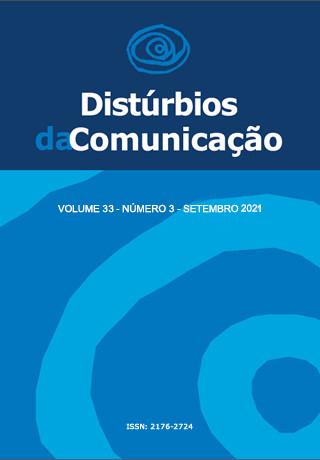Comparison between isolated phonological therapy and when associated to computerized auditory training in the rehabilitation of phonological disorders in children
DOI:
https://doi.org/10.23925/2176-2724.2021v33i3p545-556Keywords:
Speech perception, Auditory perception, Speech-Language Pathology, Rehabilitation of Speech and Language DisordersAbstract
Introduction: The auditory training is an intervention method used to improve the performance of auditory skills, aiming to enhance the processing of sound information. Objective: To assess the effectiveness of central auditory processing stimulation in the rehabilitation of phonological disorders. Method: A case study of six children aged between 6:00 and 7:11 diagnosed with phonological disorder. All children underwent speech-language assessment, with specific assessment of phonology through the Child’s Phonological Assessment (Yavas, Hernandorena e Lamprecht, 2002) and temporal processing skills through the temporal ordering and resolution tests, before and after therapy. All subjects underwent 25 therapy sessions, with three subjects undergoing only phonological therapy (study group 1 - SG1), and the other three went through phonological therapy associated with computerized auditory training (study group 2 - SG2), using the software Escuta Ativa. Results: There was no statistically significant difference when comparing the results of performance in tasks concerning the perception of the phonological system and the temporal processing in the same tests (set of tasks of listening skills) applied before and after therapy of SG1 with SG2. However, there was an improvement in the performance of temporal processing tests for SG2. Conclusion: Phonological therapy combined with computerized auditory training in children with phonological disorders did not show a statistically different difference, however it did influence the increase in the performance of temporal processing tests in these children when compared to the isolated use of phonological therapy.
Downloads
References
Mota HB. Terapia fonoaudiológica para os desvios fonológicos. Rio de Janeiro: Revinter. 2001.
Pereira LL, Brancalioni AR, Keske-Soares M. Terapia fonológica com uso de computador: relato de caso. Rev CEFAC. Mai-Jun, 2013. 15(3): 681-8.
Quintas VG, Attoni TM, Keske-Soares M, Mezzomo CL. Auditory processing in children with normal and disordered speech. Braz J Otorhinolaryngol. Dec, 2010; 76(6): 718–22.
Filippini R, Brito NFS, Neves-Lobo IF, Schochat E. Manutenção das habilidades auditivas pós treinamento auditivo. ACR. Apr, 2014; 19(2): 112–6.
Stroiek S, Quevedo LS, Kieling CH, Battezini ACL. Treinamento auditivo nas alterações do processamento auditivo: estudo de caso. Rev CEFAC. Apr, 2015; 17(2): 604–14.
Vilela N, Wertzner HF, Sanches SGG, Neves-Lobo IF, Carvallo RMM. Processamento temporal de crianças com transtorno fonológico submetidas ao treino auditivo: estudo piloto. J Soc Bras Fonoaudiol. 2012; 24(1): 42–8.
Silva MK, Ferrante C, Borsel J Van, Pereira MMB. Aquisição fonológica do Português Brasileiro em crianças do Rio de Janeiro. J Soc Bras Fonoaudiol. 2012; 24(3): 248–54.
Włodarczyk E, Szkiełkowska A, Skarżyński H, Piłka A. Zaburzenia artykulacji u dzieci ze współistniejącymi zaburzeniami przetwarzania słuchowego – efekty terapii słuchowej. Otolaryngol Pol. Sep, 2011; 65(5): 339–44.
Boaz AM, Biaggio EPV. Desempenho no treinamento auditivo computadorizado. ACR. 2019; 24: e1942.
Balen SA, Silva LTN. Programas computadorizados no treinamento auditivo. In: Bevilacqua MC, Martinez MAN, Balen AS, Lupo AC, Reis ACMB, Frota S. Tratado de Audiologia. 1ª edição. São Paulo: Editora Santos; 2011. p. 805-28.
Melo A, Mezzomo CL, Garcia MV, Biaggio EPV. Efeitos do treinamento auditivo computadorizado em crianças com distúrbio do processamento auditivo e sistema fonológico típico e atípico. ACR. 2016; 21: e1683.
Gierut JA. The conditions and course of clinically induced phonological change. J Speech Lang Hear Res. Oct, 1992; 35(5): 1049–63.
Yavas M, Hernandorena CLM, Lamprecht RR. Avaliação Fonológica da Criança. Porto Alegre: Artes Médicas, 2002.
Bernhardt B. The application of nonlinear phonological theory to intervention with one phonologically disordered child. Clin Linguist Phon. Jan, 1992; 6(4): 283–316.
AUDITEC. Pitch Pattern Sequence – PPS and Duration Pattern Sequence – DPS [CD-ROOM]. AUDITEC’s Tests; 1997.
AUDITEC. Gap-in-note test [CD-ROM]. AUDITEC’s Tests; 2015.
Alvarez AMMA, Sanchez ML, Guedes MC. Escuta Ativa - Avaliação e treinamento auditivo neurocognitivo. [Software]. CTS Informática. Pato Branco, PR; 2010
Iliadou V, Chermak GD, Bamiou D-E. Differential Diagnosis of Speech Sound Disorder (Phonological Disorder): Audiological Assessment beyond the Pure-tone Audiogram. J Am Acad Audiol. 2015; 26(4): 423-35.
Balen SA, Moore DR, Sameshima K. Pitch and Duration Pattern Sequence Tests in 7-to 11-Year-Old Children: Results Depend on Response Mode. J Am Acad Audiol. 2019;30(1):6-15.
Balen SA, Liebel G, Boeno MRM, Mottecy CM. Resolução temporal de crianças escolares. Rev CEFAC. 2009; 11(1): 52-61.
Perez AP, Pereira LD. O teste gap in noise em crianças de 11 e 12 anos. Pro Fono. Jan-mar, 2010; 22(1): 7-12.
Amaral MIR,Colella-Santos MF. Temporal Resolution: performance of school-aged children in the GIN - Gaps-in-noise test. Braz J Otorhinolaryngol. 2010; 76(6): 745-52.
Souza EK, Aguiar LB, Evangelista CKS, Nunes ADS, Lima KRA, Souza DLB, Balen SA. Reproducibility of temporal resolution tests in adults. Disturb Comun. Jun, 2019; 31(2): 308-16.
Assis EF, Parreira LMMV, Lodi DF. Teste GIN: detecção de GAP em crianças com desvio fonológico. Rev CEFAC. Jan-fev, 2013; 15(1): 79-88.
Filippini R, Wong B, Schochat E, Musiek F. GIN Test: A Meta-Analysis on Its Neurodiagnostic Value. J Am Acad Audiol. 2020; 31(2): 147-57.
Vilela N, Barrozo TF, Pagan-Neves LO, Sanches SGG, Wertzner HF, Carvallo RMM. The influence of (central) auditory processing disorder on the severity of speech-sound disorders in children. Clin Sci. 2016; 71(2): 62-8.
Downloads
Published
Issue
Section
License
Copyright (c) 2021 Paula Tavares Marchetti, Luísa Machado Dalcin, Sheila Andreoli Balen, Carolina Lisbôa Mezzomo

This work is licensed under a Creative Commons Attribution 4.0 International License.









